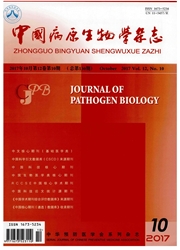

 中文摘要:
中文摘要:
目的 回顾性分析11例输入性罗阿丝虫病患者的临床特征。方法 收集首都医科大学附属北京友谊医院2012年1月-2016年7月确诊的11例输入性罗阿丝虫病患者临床和实验室数据并进行分析。结果 11例罗阿丝虫病患者均有罗阿丝虫疫区工作生活史。患者均有游走性皮下肿块,94.0%伴有瘙痒,1例患者检出眼结膜成虫。45.45%的患者进行了T淋巴细胞亚群和免疫球蛋白抗体检测,其中IgE抗体水平增高,丝虫抗原阳性。1例患者丝虫IgG4抗体阳性。血查微丝蚴均阴性。所有患者口服均阿苯达唑治疗,治疗1个疗程9例,2个疗程治疗2例,3例出现不良反应,所有患者至今随访无复发。结论 综合流行病学史分析,有游走性皮下肿块,血嗜酸性粒细胞增多,丝虫抗原和抗体阳性可诊断为罗阿丝虫病。阿苯达唑单一用药治疗罗阿丝虫病效果良好。
 英文摘要:
英文摘要:
Objective To analyze the clinic features of 11 cases of imported loiasis, including an epidemiological histo ry, clinical manifestations, and therapeutic effectiveness, seen at this Hospital from January 2012 to July 2016. Methods Clinical data on 11 cases of imported loiasis were summarized and the relevant literature was reviewed. The clinical and biological patterns of 11 cases of imported loiasis seen at this Hospital between 2012 and 2016 were described along with the treatment of those cases. Results All 11 patients had a history of visiting areas with outbreaks. Patients acquired their infection in the Congo (Brazzaville), Cameroon, Gabon, and Nigeria. Overall, Calabar swellings were observed in 100~ of patients, loiasis was accompanied by pruritus in 94%0 of patients, and eye worm migration occurred in 27.27% of patients. Microfilariae were not detected in peripheral blood of any of the patients and eosinophilia was detected in all of the patients (100%). Forty-five-point-five percent of patients tested positive for filarial antigen, and 9.09% tested positive for anti-filarial IgG4 antibodies. All 11 patients received 1 course of chemotherapy with albendazole. Two patients (18.18~) patients needed a second courses of treatment and 3 patients (27.27%) had adverse reactions. Conclusion Imported loiasis had particular clinical manifestations. A comprehensive analysis including an epidemiologieal history, specific manifestations, and an immunological test for filariasis, may help to diagnose loiasis. Chemotherapy with alben- dazole is an effective therapy for loiasis.
 同期刊论文项目
同期刊论文项目
 同项目期刊论文
同项目期刊论文
 期刊信息
期刊信息
